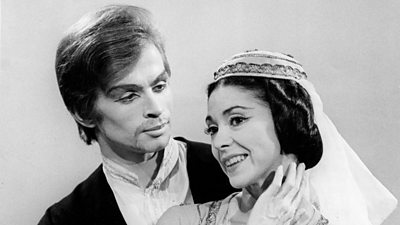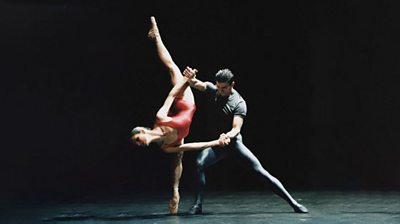Image: Alicia Markova with a television camera in "Music For You", 1957
If you had a television set in 1937 and you could have watched at 9.30 on the evening of 2 March, you would have seen a programme called Fugue for Four Cameras, arranged by Antony Tudor and danced by Maude Lloyd. This was a short dance piece especially made for the screen, where it seemed a single image of the dancer is joined by the end of the music by four images of the same dancer.
For my part, I wonder if this could be the first piece of experimental television dance made in the world. If that wasn't up your street, the day before you could have seen Mr Charles B Cochran's Young Ladies and a performance by Bob Robinson and Virginia Martin "the glamorous ballroom dancers"!
Sadly these programmes were not recorded, as nobody had yet invented video recording. But you could have seen those programmes twice, as in those early days they were first broadcast "live" in the afternoon and repeated again "live" in the evening.
So from the very early days, dance was at the heart of the 大象传媒's television schedules with the Ballet Russes, Ballet Rambert and Vic-Wells Ballet (the company that become today's Royal Ballet) coming up to the studios at Alexandra Palace in north London to perform ballets from their repertoires.
Pre-and post-war
The first dance in the 大象传媒 archive is a solo performed by a very young Margot Fonteyn, who was to be seen often on 大象传媒 television in the following years. This was also filmed in 1937 and screened as a test transmission, so - if you could afford to buy a television set - dance was one of an ever widening range of programmes available on 大象传媒 television. However, that set would have been of little use until after the war as the 大象传媒 Television service was suspended throughout the war years.
Post war, classical dance crept back into programming. So on 3 April 1953, a television version of Les Sylphides danced by Alicia Markova, Svetlana Beriosova, Violetta Elvin and John Field, was broadcast and recorded. It was recorded by pointing a film camera at a television screen and filming the result. (This method was used until the arrival of video tape in the 1960s). This is the first complete ballet in the archive, introduced by the great ballerina Tamara Karsavina who had danced in the first performance of the ballet in Paris on 2 June 1909.

From ballet to ballroom
For the next 30 years British ballet companies, including the Royal Ballet, came into the 大象传媒's studios to record memorable productions such as The Rake's Progress, Petrushka, The Firebird, The Dream, Les Noces and La Fille Mal Gardee. Overseas companies also visited, including the Bolshoi from Soviet Russia in 1956, 1960 and 1963, with such stars as Ulanova, Fedeyechev, and Plisetskaya.
However, it wasn't just the ballet companies who came to 大象传媒's studios; Kurt Jooss brought his modern dance company from Germany in 1967 to perform his great anti-war classic The Green Table and then in 1987 Merce Cunningham created a new full length piece for the screen Points in Space.
In those days, almost every Light Entertainment show had its troop of dancers. The Television Toppers, a perfect line up a girls in fish net tights and top hats, starred in many programmes as well as the very popular Black and White Minstrel Show, once seen never forgotten! All dancing, all singing production numbers were the highlights of so many variety shows, and they are still visible today in the popular repeats of shows such as Morecambe and Wise and The Two Ronnies.
Ballroom dance had its place on the 大象传媒 screen from 1937 to today. When the television service resumed after WW2, Victor Silvester's Dancing Club was a firm favourite. This led to the regional ballroom dance competition, Come Dancing, which ran for over 30 years and will long be remembered for the section with the formation dance teams. All-white tie and tails for the men and colourful dresses with lots of sequins for the ladies - even though we could only see them in black and white originally. Come Dancing was of course the precursor of today's international hit, Strictly Come Dancing.
Dance commentary
However, it's not all dance in the archive, there's plenty of talk about dance too. Dame Marie Rambert tells the story of the famous first performance of Nijinsky's The Rite of Spring (Sacre de Printemps) in Paris on 29 May 1913.
Contemporary choreographers such as Siobhan Davies and Wayne Macgregor are there discussing their work. Dame Ninette de Valois, as well, talking about the creation of the Royal Ballet, and Merce Cunningham sat in the famous Face to Face chair. There are also profiles of dancers Anton Dolin, Anthony Dowell, Christopher Bruce, all hidden away in the archive.
In 1966, Robert Cohan, who had danced with the great American chorographer Martha Graham, was invited to bring American contempory dance to the UK. Cohan formed the now much missed London Contempory Dance Theatre in 1967, and it was to change the British dance scene forever. The company is no more but many of the works are in the 大象传媒 archives. Cell, Waterless Method of Swimming Instruction, Nymphaes, and Forest have been recorded and broadcast, and can be viewed publicly at the National Film Archive.
From the 1950s to the 1970s there were popular classical music programmes on 大象传媒 One and 大象传媒 Two. Do you remember Eric Robinson's Music for You and later Gala Performance for example? These programmes nearly always included a classical ballet pas de deux and the person who performed more than anyone else was Margot Fonteyn, often with her partner Rudolf Nureyev. So the 大象传媒 archive has a wonderful record of Fonteyn's dancing, from 1937 up to her retirement.
The regular arts magazines, from Monitor to Review, also regularly featured dance, dancers and the new works that were being made, something that has been missing from the screen in recent years.
Digital dance
The digital revolution changed television and also changed dance on the screen. You no longer need a large broadcasting team and organisation to make a dance work. You can now do it yourself. This was the reason that the 大象传媒 and Arts Council England devised the series Dance for the Camera. Choreographers and directors were commissioned to make short dance films. Over fifty dance films were commissioned.
Outside In, choreographed by Victoria Marks and directed by Margaret Williams, went on to win many international awards, but also importantly to change many people's ideas about what dance could be, as it was made with the CandoCo dance company that featured both able and disabled dancers. Director David Hinton made Birds using footage of birds from the natural history archives - with not a dancer in sight, showing that you could make a dance film without dancers and still win international dance awards.
There have also been landmark series about dance. Margot Fonteyn's The Magic of Dance led the way in 1979. That was followed by two other great ballet stars of the time, Peter Shaufuss and Natalia Makarova, with their series Dancer and Ballerina. In 2002, Royal Ballet dancer Deborah Bull devised and presented a unique view of dance in her award-winning series, The Dancer's Body. This series of programmes looked at the how and the why of dance from a more scientific standpoint than that of straight performance.
The 大象传媒 archive of dance performance and talk about dance gives a unique picture of what has happened in the world of dance in the UK. More recently, the choice of works shown has been biassed towards classical ballet and the Royal Ballet, forgetting perhaps some of the cutting-edge work that is getting big audiences in our theatres. Dance is an art form that you can't read like music, so this archive is an important national asset that belongs to us all. With the digital revolution, I hope this valuable archive will be made accessible to dance enthusiasts soon.
About the author
Bob Lockyer has been working with and supporting dance for over forty years - at the 大象传媒 where he was the Executive Producer for Dance programmes and as the founder chair of Dance UK. While at the 大象传媒 he was the co-founder of the very successful and much copied series Dance for the Camera.

Dance on 大象传媒 Television
-

Dance on 大象传媒 Television
Bob Lockyer on the history of dance on TV -

Television Dancing Club
27 January 1948 -

First episode of Come Dancing
29 September 1950 -

Strictly Come Dancing
15 May 2004
